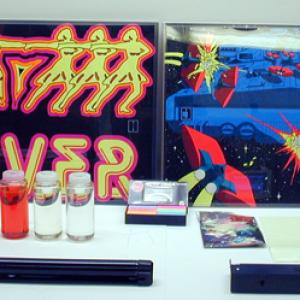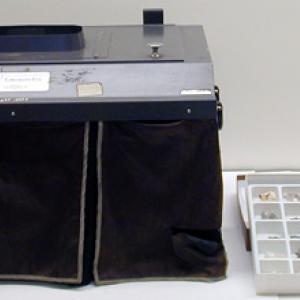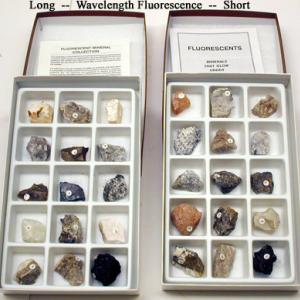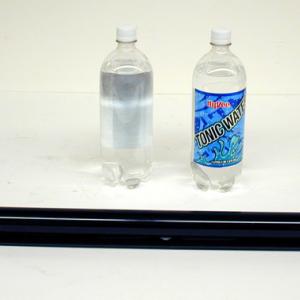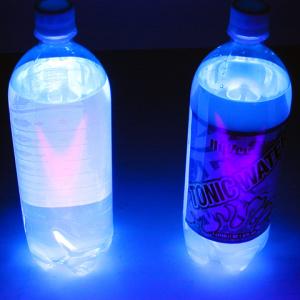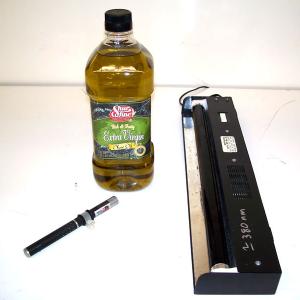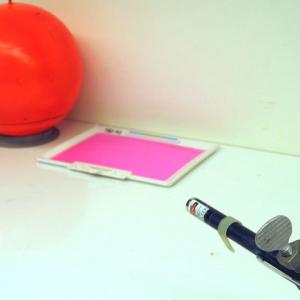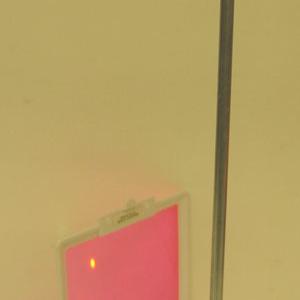College of Liberal Arts & Sciences
7B13.50 - Fluorescence - Blacklight Demonstrations
See also 7B13.50 in Chemistry and Physics of Everyday Experience.
Clamp the black lights to a table and turn on. Turn off the room lights and observe the posters and the chalk writing. Black Lights have also been installed over the blackboard in LR 1. The minerals come as two sets. One set is sensitive to short wavelength UV light and the other is sensitive to long wavelength UV.
Tonic water contains quinine which is also fluorescent.
Light sticks contain fluorescent materials. Place an un-activated light stick under a black light and observe.
If you point a green laser pointer at a fluorescent orange object, the spot will be yellow. You can go one step beyond this and shine the green laser pointer at a steep angle onto the glow doodler. The spot on the glow doodler will be yellow, but the input, transmitted, and reflected beams will all be green.
Point a green or purple laser beam through extra virgin olive oil and it will fluoresce in the yellow or orange.
Shine red, green, and purple laser pointers at fluorescent objects such as the fluorescent orange ball, the fluorescent paper, or the fluorescent clipboards.
- Jennifer J. Birriel, "Spooky Science: Turning Purple to Orange", TPT, Vol. 62, #9, Dec. 2024, p. 788.
- Yi Jinn Lillian Chen, Jiann-Shing Lih, Tzu-Chun Chen, Jeng-Fung Hung, Jing-Yuan Ko, "Chlorophyll Fluorescence: Visualizing the Inner-Filter Effect", TPT, Vol. 62, #8, Nov. 2024, p. 690.
- Ngo Khoa Quang, "A Simple Way to Demonstrate Fluorescent Image by Employing a Conventional Microscope and Transparent Colored Acrylic Pieces", TPT, Vol. 59, #1, Jan. 2021, p. 57.
- Jennifer J. Birriel, "Fluorescent Tonic Water", TPT, Vol. 55, #2, Feb. 2017, p. 128.
- Gorazd Planinšič, "Fluorescence and Phosphorescence: Easier to Investigate than to Spell", TPT, Vol. 54, #7, Oct. 2016, p. 442.
- Jennifer J. Birriel, Clarissa Roe, "Demonstrating Fluorescence with Neon Paper and Plastic", TPT, Vol. 53, #6, Sept. 2015, p. 328.
- Wen-Tang Lee, Richard Chin-Wei Chang, "Another Colorful Conundrum", TPT, Vol. 52, #8, Nov. 2014, p. 504.
- Gordon R. Gore, "Fun With Fluorescence in Olive Oil", TPT, Vol. 50, #6, Sept. 2012, p. 377.
- Carlos Eugenio Tapia Ayuga, Alfredo Luis, "Fluorescence in Cola Drinks and Caramel", TPT, Vol. 52, # 1, Jan. 2014, p. 54.
- M. Farooq Wahab, Gordon R. Gore, "Deeper Insight into Fluorescence--Excitation of Molecules by Light", TPT, Vol. 51, #5, May 2013, p. 306.
- Matt Lowry, "Colorful Conundrum", TPT, Vol. 44, #7, Oct. 2006, p. 474.
- Gordon R. Gore, "Black Light and Light Sticks", TPT, Vol. 43, #3, Mar. 2005, p. 184.
- Tom Donohue and Howard Wallace, "Ultraviolet Viewer", TPT, Vol. 31, #1, Jan. 1993, p. 41.
- Karl C. Mamola, Apparatus for Teaching Physics, "Ultraviolet Viewer", TPT, Vol. 31, #1, Jan. 1993, p. 41.
- Richard J. Fitzgerald, "Frog fluorescence", Physics Today, Vol. 70, #5, May 2017, p. 23.
- Gabriela S. Schlau-Cohen, Joseph Berry, "Photosynthetic Fluorescence, from Molecule to Planet", Physics Today, Vol. 68, #9, Sep. 2015, p. 66.
- O-760: "Detergent Boxes & Ultraviolet", DICK and RAE Physics Demo Notebook.
- 50 Fun Experiments for the Mad Scientist in You, "Glowing Hands", National Geographic Kids, p. 74.
- 50 Fun Experiments for the Mad Scientist in You, "Highlighted Water", National Geographic Kids, p. 72.
- Jodi and Roy McCullough, "Ultraviolet Light with a Power Penz-Secrets", The Role of Toys in Teaching Physics, p. 4.206.
- Martin Gardner, "A Blacklight Code", Science Tricks, p. 67.
- Janice VanCleave, "13, Brighter", Engineering For Every Kid: Easy Activities that Make Learning Science Fun, p. 95.
- Readers Digest, "Glowing Minerals", Facts and Fallacies, Wonders of the Natural World, p. 16.
- T. D. Rossing and C. J. Chiaverina, "#6, Detecting Ultraviolet Light", Light Science, Physics and Visual Arts, p. 148.
- Instruction for the Use of #12-132 Concentrated Fluorescent Dyes Set, February 1995.
- GeoScience Industries, "Fluorescents", Minerals that Glow Under Ultra-Violet Light.
- Vincent Buckwash, "Ways to demonstrate center of gravity", A potpourri of physics teaching ideas - mechanics, January 1976, p. 95.
- Kansas State University, "Modeling Light Emission to Explain Phosphorescence", Visual Quantum Mechanics The Next Generation", 2001.
- Joseph Frick, "#171 - Fluorescence", Physical Technics: Or Practical Instructions for Making Experiments in Physics and the Construction of Physical Apparatus with the Most Limmited Means, p. 200.
Disclaimer: These demonstrations are provided only for illustrative use by persons affiliated with The University of Iowa and only under the direction of a trained instructor or physicist. The University of Iowa is not responsible for demonstrations performed by those using their own equipment or who choose to use this reference material for their own purpose. The demonstrations included here are within the public domain and can be found in materials contained in libraries, bookstores, and through electronic sources. Performing all or any portion of any of these demonstrations, with or without revisions not depicted here entails inherent risks. These risks include, without limitation, bodily injury (and possibly death), including risks to health that may be temporary or permanent and that may exacerbate a pre-existing medical condition; and property loss or damage. Anyone performing any part of these demonstrations, even with revisions, knowingly and voluntarily assumes all risks associated with them.
